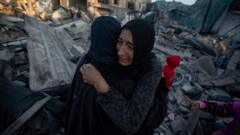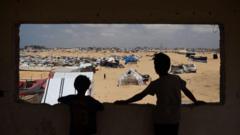The situation intensifies as Israel seizes territory while humanitarian concerns grow.
**Escalating Conflict: Israel's Intensified Efforts in Gaza**

**Escalating Conflict: Israel's Intensified Efforts in Gaza**
As tensions rise, Israel expands its military actions in Gaza amidst collapsed ceasefire negotiations.
Israel's Prime Minister Benjamin Netanyahu confirmed on April 2, 2025, that strategic military operations have led to the capture of a new stretch of land in the Gaza Strip, following the collapse of a cease-fire agreement with Hamas. This military escalation aims to enhance Israel's territorial control and to exert pressure on Hamas for the release of Israeli hostages. In a statement, officials indicated that the new strategy includes a series of intensified airstrikes targeting Hamas installations, which has prompted international concern over the humanitarian implications.
The backdrop of these actions began on March 18 when Israel initiated what it termed "extensive strikes" against Hamas, leading to the disruption of a fragile truce brokered earlier in the year. Since then, Israeli ground forces have advanced into the central Gaza region, specifically reclaiming the area known as the Netzarim Corridor, which they had previously vacated. The United Nations has reported significant displacement, with over 140,000 individuals forced to evacuate due to sweeping military orders stemming from the ongoing hostilities.
In light of these developments, Hamas has vehemently argued that Israel is straying from the commitments outlined in the January agreement, which aimed at curbing the conflict. As both parties engage in indirect dialogues mediated by international actors, efforts to re-establish a ceasefire have yet to yield results. Meanwhile, the United Nations has condemned Israel's military operations, citing numerous casualties, including the deaths of rescue workers. In response to the escalated tensions, anti-Hamas demonstrations have begun to surface within Gaza, further indicating the complex dynamics of the situation on the ground.
The backdrop of these actions began on March 18 when Israel initiated what it termed "extensive strikes" against Hamas, leading to the disruption of a fragile truce brokered earlier in the year. Since then, Israeli ground forces have advanced into the central Gaza region, specifically reclaiming the area known as the Netzarim Corridor, which they had previously vacated. The United Nations has reported significant displacement, with over 140,000 individuals forced to evacuate due to sweeping military orders stemming from the ongoing hostilities.
In light of these developments, Hamas has vehemently argued that Israel is straying from the commitments outlined in the January agreement, which aimed at curbing the conflict. As both parties engage in indirect dialogues mediated by international actors, efforts to re-establish a ceasefire have yet to yield results. Meanwhile, the United Nations has condemned Israel's military operations, citing numerous casualties, including the deaths of rescue workers. In response to the escalated tensions, anti-Hamas demonstrations have begun to surface within Gaza, further indicating the complex dynamics of the situation on the ground.























